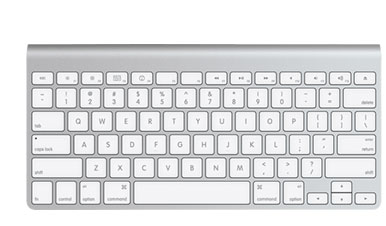Something that I had been thinking about recently is what move might Apple make next to revolutionise the way that we interact with our computers. Touch is definitely here to stay, but I don’t see why that should be restricted to mobile devices such as the iPhone and iPad.
My first thought was that the MacBook Air will get an update to replace the traditional keyboard with a touch panel – so that the trackpad in effect becomes the entire input device, but is as large as the surface taken by the conventional keyboard and trackpad. This surface would not just be touch enabled, but would act as a visual surface/display, i.e. like the iPad appears.
The great advantage here is that the touch surface becomes completely programmable and could be adapted to suit individual applications. Some apps might promote numeric input, some might provide app specific widgets, etc. Certain applications might provide novel input methods, for example a DJ mixing desk with sliders and knobs, or painting application that provides a colour mixing palette. Gestures could also be implemented to fit in with applications requirement, such as swipe left/right for back/forward in a browser.
But I then had a flash of inspiration caused by one of those random events, a spam comment on this blog! It was questioning whether anyone would actually use the Apple Wireless keyboard in conjunction with the iPad, somerthing that I purchased one along with my iPad but now use it exclusively with my MacPro on the desktop. The iPad soft keyboard copes well for the amount of keyboard input required with most iPad apps. But then came the flash! Why not use the iPad as the wireless keyboard for my MacPro, day in and day out?
I already use an application called TouchPad on the iPad to provide me with a wireless touchpad and keyboard remote for the MacPro (which doubles up as a media centre at night). That way I can sit on the sofa and control the movies. But here I am now, typing this post using the TouchPad application. It’s working reasonable well – there is some issue with the lack of tactile feedback from the keys and I can’t feel the edges so have to look to keep my hands aligned. Also that some punctuation is hidden and requires the keyboard mode to be toggled, but I am making a reasonable stab at regular touch typing. The top half of the display is acting as the trackpad, although this seems like an odd placement choice, given that all laptops have the trackpad below the keys. I suspect this is because the keyboard is the iPads popup soft keyboard, and that always slides in from the bottom. I shoulf also say that I’m using the Apple iPad case, and its propped in landscape mode. This gives the largest keyboard presentation, and a good typing angle, similar to a regular keyboard.
So the next question is, why stick with the standard QWERTY layout? This is one of those hangovers from the days of mechanical typewriters, and there are other keyboard formats available that are arguably more ergonomic. Of course, the reason that QWERTY still exists is to do with its familiarity – too many of us would now need retraining. But the advantage of a soft keyboard is that you could in fact switch easily between any keyboard arrangement to suit the job at hand. And it intrigues me to think what other type of input control might be useful. Could we see a reduced keyboard and predictive text become established, which borrows from the large user base of phone users? Could gestures replace the need for a keyboard?
If you have an iPad, and download TouchPad or one of its competitors, let me know if you think that this could be the start of something different.



